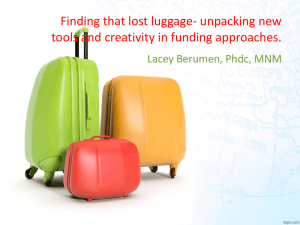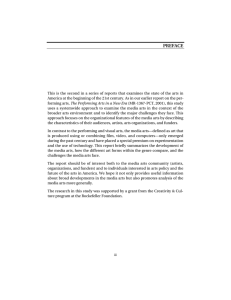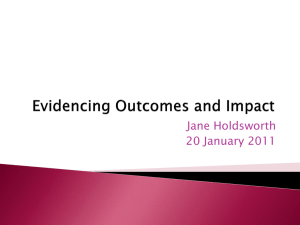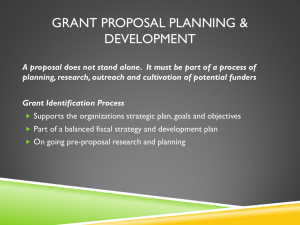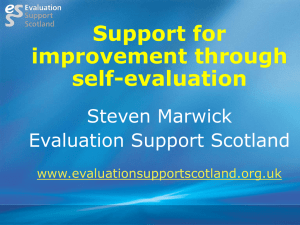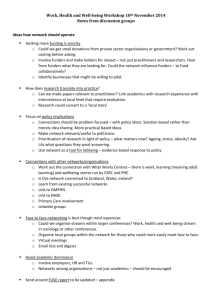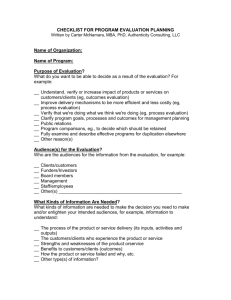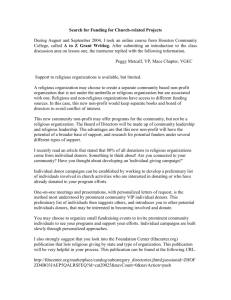Current Research Journal of Social Sciences 2(4): 249-254, 2010 ISSN: 2041-3246
advertisement
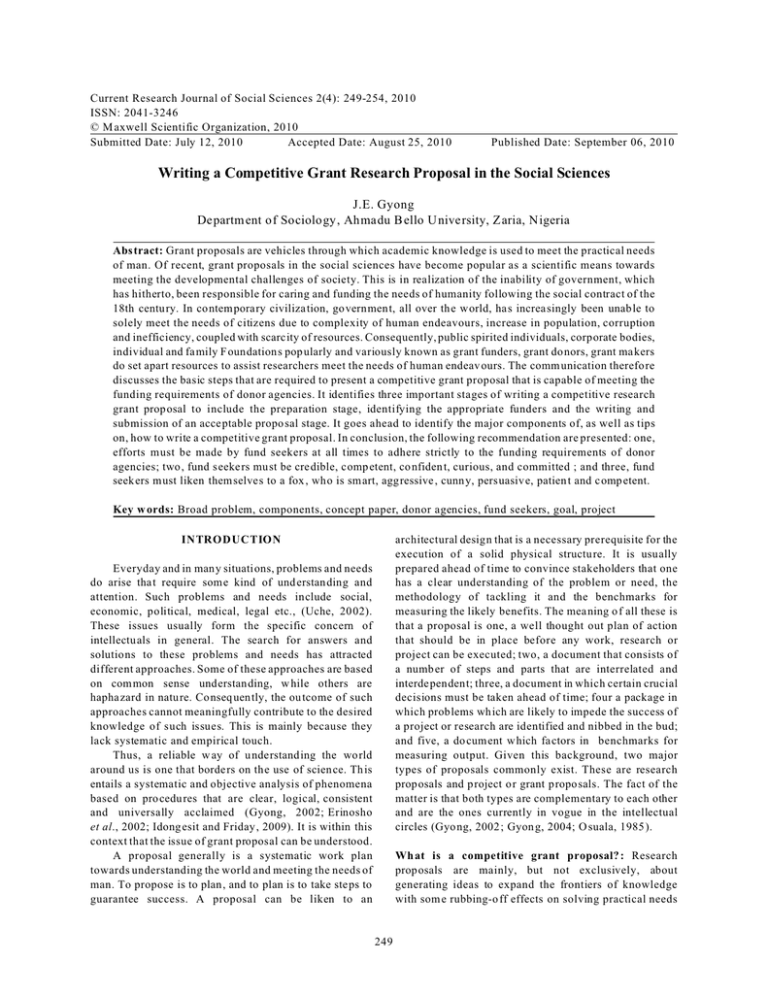
Current Research Journal of Social Sciences 2(4): 249-254, 2010 ISSN: 2041-3246 © M axwell Scientific Organization, 2010 Submitted Date: July 12, 2010 Accepted Date: August 25, 2010 Published Date: September 06, 2010 Writing a Competitive Grant Research Proposal in the Social Sciences J.E. Gyong Departm ent of Sociology, Ahmadu B ello U niversity, Zaria, Nigeria Abstract: Grant proposals are vehicles through which academic knowledge is used to meet the practical needs of man. Of recent, grant proposals in the social sciences have become popular as a scientific means towards meeting the developmental challenges of society. This is in realization of the inability of government, which has hitherto, been responsible for caring and funding the needs of humanity following the social contract of the 18th century. In contem porary civilization, governmen t, all over the world, has increa singly been unab le to solely meet the needs of citizens due to complexity of human endeavours, increase in population, corruption and inefficiency, coupled with scarcity of resources. Consequently, public spirited individuals, corporate bodies, individual and family F oundation s pop ularly and variously known as grant funders, grant do nors, grant ma kers do set apart resources to assist researchers meet the needs of human endeav ours. The comm unication therefore discusses the basic steps that are required to present a competitive grant proposal that is capable of meeting the funding requirements of donor agencies. It identifies three important stages of writing a competitive research grant proposal to include the preparation stage, identifying the appropriate funders and the writing and submission of an acceptable propo sal stage. It goes ahead to identify the major components of, as well as tips on, how to write a competitive grant proposal. In conclusion, the following recommendation are presented: one, efforts must be made by fund seekers at all times to adhere strictly to the funding requirements of donor agencies; two, fund seeke rs must be cre dible, comp etent, co nfiden t, curious, and committed ; and three, fund seekers must liken themselves to a fox , who is smart, aggressive , cunn y, persuasive, patien t and comp etent. Key w ords: Broad problem, components, concept paper, donor agencies, fund seekers, goal, project architectural design that is a necessary prerequisite for the execution of a solid physical structure. It is usually prepared ahead of time to convince stakeholders that one has a clear understanding of the problem or need, the methodology of tackling it and the benchmarks for measuring the likely benefits. The meaning o f all these is that a proposal is one, a well thought out plan of action that should be in place before any work, research or project can be executed; two, a document that consists of a numb er of steps and parts that are interrelated and interdependent; three, a document in which certain crucial decisions must be taken ahead of time; four a package in which problems which are likely to impede the success of a project or research are identified and nibbed in the bud; and five, a do cum ent w hich factors in benchmarks for measuring output. Given this background, two major types of proposals commonly exist. These are research proposals and p roject or grant proposals. The fact of the matter is that both types are complementary to each other and are the ones currently in vogue in the intellectual circles (Gyong, 2002 ; Gyon g, 2004; O suala, 1985 ). INTRODUCTION Everyday and in many situations, problems and needs do arise that require some kind of und erstanding and attention. Such problems and needs include social, economic, political, medical, legal etc., (Uche, 20 02). These issues usually form the specific concern of intellectuals in general. The search for answers and solutions to these problems and needs has attracted different approaches. Some of these approaches are based on com mon sense understanding, w hile others are haphazard in nature. Co nseq uently, the ou tcome of such approaches cannot meaningfully contribute to the desired knowledge of such issues. This is mainly because they lack systematic and empirical touch. Thus, a reliable w ay of u nderstanding the world around us is one that borde rs on the use of scien ce. Th is entails a systematic and objective analysis of phenomena based on pro cedu res that are clear, logical, consistent and universally acclaimed (Gyong, 2002; Erinosho et al., 2002; Idong esit and Friday, 2009). It is within this context that the issue of grant proposal can be understood. A proposal generally is a systematic work plan towards understanding the world and meeting the needs of man. To propose is to plan, and to plan is to take steps to guarantee success. A proposal can be liken to an Wh at is a competitive grant proposal? : Research proposals are mainly, but not exclusively, about generating ideas to expand the frontiers of knowledge with som e rubbing-o ff effects on solving practical needs 249 Curr. Res. J. Soc. Sci., 2(4): 249-254, 2010 C of man. But grant proposal is the vehicle in which academic knowledge is used to meet the practical needs of humanity. It is a plan that transforms an intellectual idea towards practical intervention to solve existing human needs. This involves defining a need, identifying the goal, objectives and target beneficiaries of the need, as well as formulating a plan of action towards achieving measurable results or outcomes. Grant proposals are usually based on empirical needs assessment or baseline studies tha t establish the current state of the target beneficiaries. Thus, it is the detailed work plan of transforming such empirical ideas to meet the practical needs o f the target beneficiaries that are contained in a grant proposal. In other words, grant proposals constitute the vehicle through which empirical ideas are used to meet the practical needs of humanity. W riting grant proposals has recently become a major component of intellectual vocation in the social sciences. Traditionally, the funding of hum an needs has large ly been the resp onsibility of gov ernm ent. Th is is in deed pa rt of the social respon sibilities of governmen t arising from the social contract of the 18th century. However, du e to the complexities of human endeavors, increase in population, corruption and inefficien cy, coupled with scarcity of resources, the task of meeting human needs has gone beyond that of governmen t to includ e pub lic spirited individuals and corporate bodies popularly and variou sly referred to as Grant Funders, Grant Donors or Grant Makers. Such funders are usually corpo rate bodies; individual or family Foundations who often set aside money to assist researchers meet the practical needs of man in various asp ects of hum an Endeavour. The specific focus of this communication is on how researchers can write comp etitive grant proposals that are capable of meeting the funding requirements of donor agencies. C C C C C C The concept paper provides one w ith an opportunity to persuade funders that ones project is not on ly worthwhile, but has potentially achievable and mea surab le outcomes. Concept paper also helps to hook one to the funders and make them see the rationale the project should have an edge over o ther pro posa ls. This requires that the fund seeker be neat, professional and organized. Identifying the appropriate funders: Following the concept paper is a pre-proposal contact. This contact can confirm interests and can make a big difference in being funded. Different funders have different interest. It is the respo nsibility of the grant see kers to locate or identify the funding body that can ho ok up with their pro ject interest. Thus, after the concept paper, grant seekers then must look for funders that are interested in their pro ject. Usually, information on donor agencies is available on their web sites, donor develo pme nt offices and public libraries. The grant seekers are to look for consistency between the goal of their project and the funder’s interest. Thereafter, the following additional steps can be taken: Stages of w riting a com petitive gran t proposa l: The preparation stage: The preparation stage is the initial and m ost imp ortant, and probably the most time consuming. Usually, this stage begins with the preparation of a concept paper. The concep t paper is usually a very brief statement of the need, but contain s enough details for donors to understand the essence of the project. Upon review of the concept paper, grant seek ers w ill then be informed by the donors if they are to su bmit a full proposal. The format for a concept paper is as follows: C State the overall goal of the set of interventions for which the funders will support. Describe what you ultimately hope to accomplish with the dono r’s support by a set of proposed interventions. State the strategic ob jectives for achieving the goal. Describe how the proposed intervention w ork together to form a strategy to accom plish your overall goal. List the strategic objectives and proposed interventions. State the expected outcomes. Briefly describe shortterm measurable results of the proposed package of interventions. List the key p ersons accountable for the project. A statement of the total amount being requested. A statement of timeline for the project w hich should include execution, dissemination of findings and evaluation. A request for application form. C C C C Your NG O or organization’s mission, strategic vision and documented priorities. You may need to attach supporting docume nts that describe you r strategic directions and priorities. This is often best accomplished through a strategic plan of action that involves the assessment of the Strength, Weaknesses, Opportunities and Threats (SWO T) of the grant seekers’ organization. C C C 250 Make direct co ntact w ith the donors requesting them to support projects like yours. Request for proposal guidelines Inquire about the maximum grant and other details. Inquire whether the dono rs have other grant sources for which your project is eligible. Identify a desk officer or project officer who will be the contact person Inquire abou t the possibility of technical assistance e.g. a review of draft proposals. Inquire about budgetary requirements and preferences e.g. are matching grants necessary, the place of in-kind, non cash contributions Curr. Res. J. Soc. Sci., 2(4): 249-254, 2010 C C C Inquire abou t propo sal guidelines wh ich should include submission deadline eligibility; proposal format; font size; evaluation process and restrictions on the number of pages etc; timelines; budgets, funding details and award levels; evaluation process and criteria; w ho to contac t and other submission requirements. Determine your personnel needs. This should be determined by the function of each personnel in the projec t. This should include project consultants, trainers, secretariat staff and auxiliary personnel and acquire permission to include them in the project and negotiate com pensation. Personnel compensation is important information for purposes of budgeting. C C C C Writing Stage: At this stage, one already has quite sufficient and detailed information about the donors and their requirements. You also may have carried out your baseline study on the needs assessment of the proposed beneficiaries of the project. The baseline study shows the current state of the problem requiring intervention. It also serves as a benchmark to measure the potential level of success of the intervention measures packaged in the proposal. At this stage therefore, one is sufficiently armed to write a full compe titive gran t propo sal. Brainstorming enables one to identify as many com ponents of the overall picture of the need as possible. In stating the broad problem , there is also need to conduct literature search. This will reveal what aspects of the broad problem have been addressed, to wh at exten t, by whom, how and when. The process of brainstorming and literature search will reveal many problems or needs than one project can possible address. It is out of these m any problems or needs that the specific problem or project is usually selected for attention and therefore funding. Specific problem statement: C This is usually the project that requires funding. C It is usually a part of the broad problem. C It is usually a logical narrative description of the need or problem to be addressed. C It usually includes results of empirical studies on the needy target population that should have been conducted by the grantee. C Consequently, it presents factual and empirical evidence on the nature, manifestation and impact of the problem on those affected. C It should also contain historical or background information on ho w the situation cam e abo ut and therefore the scope of the need. C It is usually measurable and achievable within the lifespan of the project. C Its accomplishme nt or resolution shou ld usually contribute to solving the broad problem. C The selection of specific problem mostly depends on donor’s guide in terms of geographical location, focus, amount of grant and target population. C It also depends on other sources of funding availab le to the grantee. M ajor com pon ents o f a gra nt winning proposal: The project topic: C This is usually the ce ntral focus of the project. C All the com ponents of the project are b uilt aroun d it. C It is usually stated in a subjective manner to give the picture of the existence of a need or needs requiring some intervention measures. C It should state or co nvey a d eclining state of a situation requiring the need for intervention. The follow ing are exam ples of project topic B Gender inequ ality in Education in Northern Nigeria. B Material an d Child D eath in Northern N igeria B Poor Rural Infrastructure in Nigeria. B HIV/AIDS Infection Among Y outh in Nigeria. B Falling Standard of Education in Nigeria. Go al: C This is usually the vision of the project. C It is the solution to the broad problem. C It is a long term vision that may not be achieva ble within the lifespan of the project. C Usually, the goal requires collaborative effort and long term to be fully addressed. C It is usually a sho rt, but rather, positive statement of a desired change of situation. C It is usually a strong action statement, lofty, inspiring and emphasis is on the expected beneficiaries of the projec t. The broad problem: C This is the overall statement of a compelling need or problem to be addressed. C It can also be considered to be a holistic statement or picture of a compelling need or problem to be addressed. C It represents the context within which the specific problem exists. C Thus, it is a statement of the overall need. C Grants are usually meant to address either part or whole pro ject. C In stating the broad problem, the re is nee d to brainstorm. Project objectives: C These are clea r statements of specific outcomes that are measurable and time specific. 251 Curr. Res. J. Soc. Sci., 2(4): 249-254, 2010 C C C C They are also statements of solutions to the sp ecific problem. They are positive statements of desired chan ge w ithin the lifespan of the project. W hen the objectives are achieved then part of the goal would also have been attained. C Budget is the monetary cost implication of the projec t. It expresses in words and figures all the resources needed to fully ca rry out the project from start to finish. Typical bud get ca tegories, w ith m any possible variations: C Personnel costs salary for all full and part-time perso nnel working on the project. C Personnel fringe costs: expressed as a % of salary, recalculate this periodically. C Contractual costs: task done by contract, not on salary, include consultants. C Construction/renovation: office or work space remodeling or new building. C Materials long-life consumables like books, softw are etc. C Supplies: short-life consumables like pens, letterhead paper etc. C Equ ipment: durable goods like computers, desks, work tools, equipment to be provided to beneficiaries; vehicles (m ay be sep arated). C Vehicles (if separated): delivered prices of cars, motorcycles and other vehicles. C Travel often divided into subsections such as air, ground, and other C Air transport number of tickets at the average cost for each destination C Ground transport may be kilometer cost figure, or listing of actual vehicle costs such as repairs, maintenance, fuel, insurance, registration C Other travel allowances for meals and lodging; public taxis, bu s, boat etc. C Comm unications: phone, postage, exp ress delivery services, internet access. C Facilities: rent and utilities for offices, work spaces, public functions. C Miscellaneous items not easily fit elsewhere like passport and visa fees. C In-kind non-cash contributions not included in indirect cost, assigned fair value, such as part-time use of equipment like copier, materials, supplies, volunteer time of your ag ency, partne rs, beneficiaries, use of facilities (meeting and w ork space) C Indirect none ‘billable’ costs for maintaining your organization such as the cost of Board meetings, salaries of Chief Executive an d financial staff, marketing, programme developm ent, indivisible costs of headquarters and field offices: calculated yearly. Com ponent: C These are also called outcomes. C They are goods and/or services the project desires to provide. C These could be in form of equipm ent, facilities, training, manpower, infrastructure etc. C The components taken together are typically interdependent, synergistic and integrated. C The accomplishment of all the components signifies the attainment of all the stated objectives. Activities: C These are also called inputs. C These are the specific tasks that need to be accomplished or undertaking to effectively realize the delivery or provisions of the desired goals and/or service. C In other words, these are are the series of activities needed to be carried out for the full realization of the componen ts. C Each component has series of activities necessary for its accomplishme nt. Implementation plan: C This is a detailed step-by step description of how the project will be implemented or executed from start to finish. C This should include what to be done by whom and when. C It also includes what tools or machinery are needed. Timeline: C This is a well-develope d schedule for the successful exec ution o f the project. C It should be realistic. C A well developed timeline helps convince the reviews or donors that the grantee is organized and thorough. C It also shows that one has thought through the project long term needs and goals. C Thus, it enhances the chances of the proposal being funded. Bud get: C The whole idea of a grant proposal is to get funding from donor agencies to meet identified needs. C Budget therefore becomes a very vital component of the pro posa l. C How it is stated w ill go a lon g way to determine ones chan ces of being funded or n ot. Tips for budgeting: C Early in the project proposal phase start to think about cost implications of various options, and then to begin listing resources needs as the design takes shape. 252 Curr. Res. J. Soc. Sci., 2(4): 249-254, 2010 C C C C C C C C C C C C C C C C C C Few donors pay for everything; list other sources including in-kind contributions. If you need more funds than requested of one donor, indicate additional needs with a ‘to be raised’ column in the budget, and explain your fundraising efforts. Include any anticipated income: fees from services, interest, re-sale, and cost-recovery. Computer spreadsheets greatly ease budget development and are easily learned. Don ’t miss anything: your NGO must cover what you discover m issing later. Be more detailed rather than less; avoid trying to get away w ithout explanations. Check o ut figures in detail. Be realistic; budgeting is the art of the possible: ask only for what you really need. Read, re-read, memorize your don or’s directions; ask about what you don’t know. Some donors do not want to buy vehicles, but pay for travel: know these patterns. Present a rational for sizable budget item: why three new com puters? Exp lain any ‘formu las’ you used to arrive at certain figures, allowan ces, and kilometer. Offer persuasive evidence for need of major items, including personnel, travel, contractual services, and any unusually large or numerous items in your budget. The reader shou ld say: yes, of course they need this item to d o the job right. Justifications work best when co nnected back to project activities and objectives. Keep justification short and concise, use bullets and phrases. For a large, complex budget: include spreadsheets on which it is based. C C C C C C C C C C C Abstracts/executive summ ary: C This is the summary presentation of the key elements. C It is usually not more than two pages. C Appen dices: C These are important additional materials or information that would aid the grand makers or review ers have a m ore lucid picture of the project. C These include maps, charts, tables, letters of recommendation/commendation curriculum vitae of key project staff etc., (Gyong, 2004; Fundraising Fundamentals, 2003) C C TIP S on how to write a com petitive gran t proposa l: C Read, understand and follow diligently the guidelines and instructions, including deadlines of the funders. 253 Understanding the timing and constraints. Try to inquire for when the best time to submit a proposal to any funding agency. For even the best proposal is doomed to be rejected if it comes in after the deadline. Carry out a needs assessment and present the result. It can strengthen your case. Endeavour to carry out a sho rt literature review to show evidence that you know about the works other persons have done on the problem and identify the gaps yet to be filled. Have you r proposal reviewed by trusted colleagues, including those outside you r field and hee d to their comme nts. Talk to those who may have benefited from similar grants. Ensure that you hav e a track record of doing research and publishing in the area. Diversify your search for sources of fund ing; don’t just go to popular funders. Avoid terms that are too technical or might not be understood outside your field: Some of the reviewers may be coming from outside yo ur field, but need to understand the proposal sufficiently en ough to determine your chances of being funded. Send only p roposals that meet the expressed interest of the proposed funders and not just y our interest. Keep your proposal as simple and concise as possible and avoid being too detailed. En sure you state clea rly what the need is, expe cted results and how they w ill be evaluated. Narrate a compelling picture of the difference the funding will make. Editorial checks: Reme mbe r that reviewers correlate poorly edited work with incompe tence. Be neat, use proper size type an d adh ere to page lim it. Avoid unrea listic estimates: You can be sure that some review ers w ill have experien ce in your field and lower their rating of you if you prom ise more than you can achiever or deliver. Tailor your project to the amount of money available. It is very counter productive to submit a proposal that exceeds what your founders can fund. A lso be sure that you don’t describe a T en m illion Dollar need if you are asking for only Two million D ollars. In fact, you can explore additional sources of funding elsewhere to reduce the burden on your funders. Do not omit important items or information, especially on the budget. Otherwise, you have to source for money from elsewhere to make-up. Follow up: Every funding agency has a desk officer or programme officer who will be in charge of any particular project. Unless funders expressly limit contacts, make phone calls, send e-mail messages or even pay a visit, if possible, to inquire if the proposal Curr. Res. J. Soc. Sci., 2(4): 249-254, 2010 C C C was received and any other additional information. Such follow ups have the advantage of straightening out misconceptions and faulty assumptions on the part of the reviewers. Make your first page the executive summary, which shou ld summarise your whole case for consideration. This should include your mission statement, project goal, strategic objectives, proposed activities, expected outcome, key staff, amount requested and time-lines. Take rejection in goo d faith. Excellent researchers can have their proposals rejected, take it as a learning experience and ask the funders w hat could have been done to m ake the proposal stronge r. If you are funded, be sure to thank the funders and make appropriate progress (Howard et al., 1999; Erin, 2002; Simon an d Alan, 2006). curious, com mitted and comp etent. Thus, a grant seeker can be liken to a fox who is smart, aggressive, cunny, persu asive, patient and comp etent. REFERENCES Erin, M., 2002. Fund raising from corporations and foundations, University of Iowa Foundation. Erinosho, L., et al., 2002. Interdisciplinary M ethod ologies in the Social Sciences ASCON FIRESEED and Co. Ltd., Abuja. Fundraising Fundamentals Course Material, 2003. Pamoja Inc., New Y ork. Gyong, J.E., 2002. B asic Issues in Social Research, Department of Sociology, A.B.U., Zaria. Gyong, J.E., 2004. ‘Proposal W riting’ presented at a workshop on Strategic Skills D evelo pme nt in HIV/AIDS Programm ing for NGOs’. Social Sciences and Reproductive Health Research Network, Ibadan. Howard, S., G. Riegler, M. Shull and R. Kennicutt, 1999. How to write a W inning Grant Proposa l. Business Meeting Supplementary Session, Chicago. Idongesit, I.A. and S.B. Friday, 2009. Research Methodology and S tatistics in Health and Behavioural Sciences. Osuala, E.C., 1985. Introduction to Research Methodology. AFRICANA-FEP Pub. Ltd., Onitsha. Simon, P.J. and B. Alan , 2006. W riting a Good Grant Proposal. Retrieved from: http:/homepages.inf.ed. ac.uk /bund y/how -tos/rsg-h ow-to-get-fu nding .html. Uche, C.I.A., 2002. Quantitative Research Tech niques. Currents and P erspectives in Sociology. Malthouse Press Ltd., Lagos, Nigeria. CONCLUSION It has been the intention herein to equip readers w ith the basic skills of writing competitive grant proposals that enab le them attract funds to meet developmental challenges of society. Generally, the identified needs and the requiremen ts for meeting them shou ld be the focus of any grant proposal. The chances of any grant proposal being funded largely depend on its quality and how it hooks on to the interest of the funders. Consequently, efforts must be m ade by fund seekers to adhere strictly to the fundamental requirements of funding agencies. The grant seekers themselves must be credible and competent individuals, having confidence in them selves and are 254
